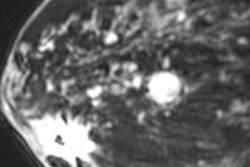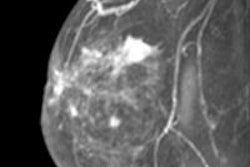
MRI evaluation following breast cancer diagnosis can improve a woman's long-term prognosis, as the modality is able to detect lymph-node metastases associated with poorer outcomes, according to research presented on May 3 at the American Society of Breast Surgeons (ASBS) annual meeting in Chicago.
In breast cancer patients diagnosed through routine screening mammography, those with additional invasive lesions identified by breast MRI were more than twice as likely to have cancerous nodes than patients with a single invasive lesion, concluded the study group from Michigan.
"Because patients with lymph-node metastasis tend to have a poorer prognosis, patients with cancers that have spread to the lymph node are treated more aggressively than those without nodal involvement," said lead researcher Dr. Sukamal Saha from MacLaren Flint. "Appropriate assessment would increase the likelihood of detecting all nodal involvement, leading to more timely and potentially effective treatments."
 Dr. Sukamal Saha from MacLaren Flint.
Dr. Sukamal Saha from MacLaren Flint.Saha and colleagues conducted a study of 425 breast cancer patients who had both mammography and breast MRI. They compared the number of positive nodes in patients with multiple invasive lesions found on MRI versus the number of positive nodes in those with single invasive lesions found on MRI or mammography. All study participants had sentinel node mapping.
MRI detected multiple lesions in 107 patients, 80 (18.8%) of which were not found by mammography, according to Saha. Of these 80 lesions, 36 (45%) were invasive, 36 (45%) were benign, and eight (10%) were ductal carcinoma in situ. When the team compared patients with single malignant lesions to those with additional malignant lesions detected by MRI only, the rate of positive nodes more than doubled, from 21.2% to 47.2%.
"This day and age, we're diagnosing more and more early-stage breast cancer," Saha told AuntMinnie.com. "And in patients with dense breast tissue, MRI can find additional cancers that mammography misses, which changes the whole treatment plan. When we know a patient has disease in their lymph nodes, we can start them immediately on systemic treatment, and we find that down the line they do better."
The current healthcare reform climate -- and its associated cost-cutting measures -- is minimizing the use of breast MRI for prognostic purposes, and that could lead to increased costs later, according to Saha.
"We want to stress the value of breast MRI as a prognostic tool for nodal involvement, since it could potentially help enhance patient outcomes and cut added costs of additional treatments at a later date," he said.



















